Pat Mills’ brilliant script and characters for Charley’s War would not have been able to so fully come to life without the other half of the team: Joe Colquhoun.
Original feature published by Neil Emery
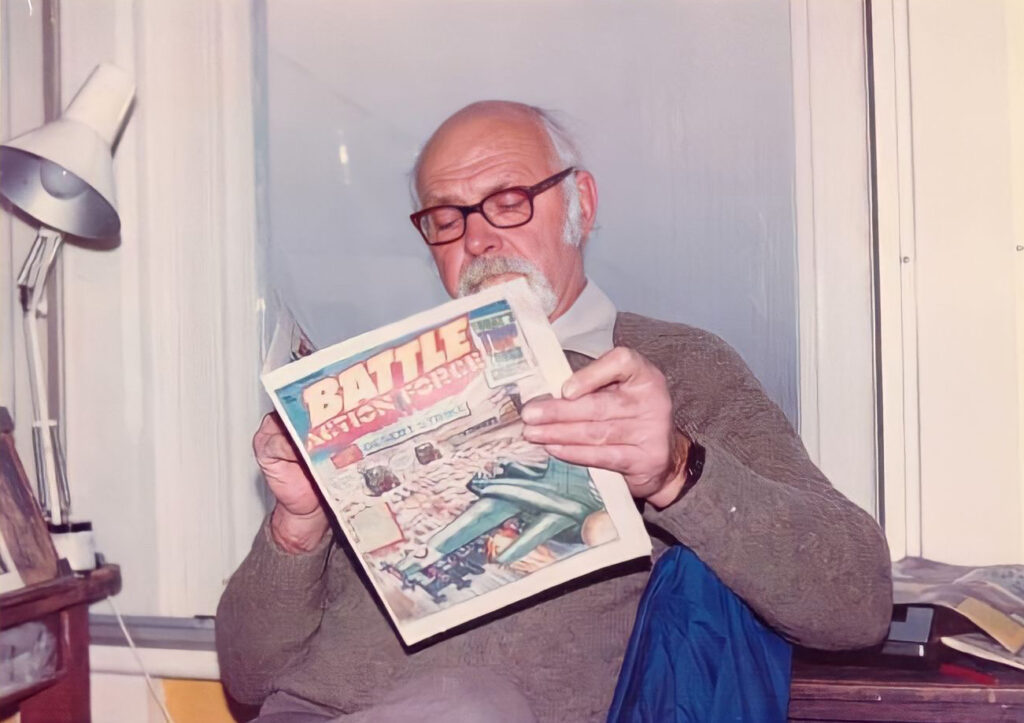
Joe was born in Harrow, Middlesex in 1927. He had always wanted to be Comic artist, but the Second World War loomed. He was called up as an 18-year-old in 1944, and served in the Royal Navy during World War Two, mainly in the Mediterranean. He saw little action, if any, and somewhat resented spending his salad days swabbing decks in the sunshine.
Joe down played his part in Hitler’s downfall, and said he never saw action and wasn’t a hero, but who knows? I think all of the guys who fought the war were heroes, whatever capacity they served in.
After the war when he was demobbed from the Naval life he had grown to love he landed a place at Kingston School of Art, and broke into the field of comic artist in the harsh financial climate of the 1940s.
His first published work was “Carver of the Islands”, which appeared in the comic Jungle Trails in 1951. He then worked for IPC magazines for 30 years starting on Lion and, two years later, fellow publication Tiger.
He was the very first of many artists to draw “Roy of the Rovers” (sometimes Joe took over writing the script as well when the writer had a heavy workload). He drew the Footballing hero for six years, even though he openly admitted he hated football!.
He spent the rest of the 1960s working on shorter stories for Lion and Tiger and, at the start of the 1970s he began working on humourous comics like Buster and Cor!.
Dez Skinn, his editor on Buster wrote this of him in response to this site: “I had the wonderful opportunity of working with Joe in the mid-’70s. I wouldn’t call his Buster work ‘humour’ as he produced a fabulous two-page weekly full colour strip ‘Kid Chameleon‘. This predated his Battle work, but is one of those forgotten wonders of British comics.
“I remember driving out to visit him at his home and he was as wonderful a person as he was an artist. I only regret his brilliance wasn’t realised in his own lifetime and that it’s only now being appreciated.”
He also drew the story “Zarga – Man of Mystery” from 1972-1973 for Buster until Dave Gibbons took over. “Zarga” was co-written by Scott Goodall, who he was to work with again ten years later when Goodall took over the writing of “Charley’s War” from Pat Mills.
At some point in this period Joe’s love of the sea would prove too much of a pull and he moved to Swanage in Dorset in a disused Lighthouse. Dave Hunt seems to remember he joined a sailing club and spent most of his free time messing around in a small boat he had brought himself.
Joe stayed on Buster for about six years. He did a variety of strips which included “The Goodies”, “Sammy Brewster’s Ski-Board Squad” (also co-written with Goodall) and “Sam’s City Jungle”.
Joe started work at Battle Picture Weekly in 1976. For a few months he drew a story called “Soldier Sharp – the Rat of the Rifles” until he started on “Johnny Red” – the story of the British pilot flying with the Russians in World War Two (script by Tom Tully).
He drew “Johnny Red” for two years before Dave Hunt (Battle‘s editor at the time) teamed him up with Pat Mills for “Charley’s War” in 1978.
Battle editor Terry Magee said in 1986: “Joe’s pictorial interpretation shows an involvement of one hundred per cent plus. I’ve never before known such dedication.
“From his home in Dorset, Joe spends five full working days to complete just one episode of three pages. It is not financially rewarding in the same way when compared to other artists who produce three times that amount but Joe can’t help himself he says, preferring to apply his mind and brushes to putting all he can into each frame.
“That’s why it’s such superb stuff, with those incredibly detailed backgrounds.”
In 1982, Joe suffered a heart attack and I can still remember being devastated and hardly reading the comic while he was away recovering. (No other artist impressed me and no other story interested me, I’m sad to say) I sent him a get-well soon card with a drawing of Charley Bourne on it that I’d done myself (he must of been quite sick of that character sometimes)!
He was soon back, however, and I continued buying Battle until ‘Charley’s War’ saw Charley returning to a country in financial ruin. I stopped getting it then, because adolescence had caught up with me and I thought myself far too hip to be buying a ‘kids’ comic.
‘Charley’s War’ continued, however, into World War Two and finally came to an end on the 4th October 1986.
Joe continued to work right up to his death a year after. He produced ten one-off stories for Mask in 1987 and his last piece of work was a story called ‘Mayhem’s Column’, which appeared in Mask in the issue cover dated 25th September 1987.
Personal friend Derek Bate recalls: “I met Joe in the early 1980s at Swanage Sailing Club. We used to sail together in his small Heron dingy and my rather larger boat. We discussed many topics and I believe he was in the navy and must have have been an influence in his drawings.
“I visited his studio and saw him work and how he approached his drawings. Pure genius! This overwhelmed my son, who was only young then, but he has never forgotten the experience to this day. A good man to know, quite reserved, and I was surprised to hear of his death.”
Joe Colquhoun was an Unknown Genius, his talent was almost magical – and this site is really a dedication to him.
I was extremely saddened on hearing he was dead, as now I will never be able to interview him for this site or tell him how important an influence he was on me and simply shake his hand to thank him. Thanks to the Titan Books reprints of ‘Charley’s War’, his great artwork will live on though, and his influence on younger artists such as myself will always re-enforce that.
Some of Joe’s art from episodes of ‘Charley’s War’ I don’t own anymore is still imprinted in my mind 22 years later. For instance, I remember vividly the episode where the Germans took the trench he was in and shouted down the dugout steps for the Tommies to come up one-by-one, shooting them when they reached the top. Charley climbed up the ventilation shaft and saved the day, Lewis gun blazing. I can remember this as if it was yesterday – frame for frame – and yet I know for a fact it was 1980…when I was 9!
There are a lot of his images I can recall in the same way. I could spot his work a mile off I had studied it so much, when I got some older issues from a jumble sale, when I was about eleven, and ‘Charley’s War’ wasn’t in it, my disappointment was relieved when I saw ‘Johnny Red’, instantly I recognised the un-credited art as Joe’s. To me he was unequaled, and he remains so. I can remember the individual frames and colour covers, the expressions and settings – the whole thing. Joe’s art really did stick with you, and that, I think, has got to be one of the best epitaphs for any artist.
In an e-mail regarding this site, Pat Mills, said this of his old partner.
“Like you, I also, I feel very strongly about Joe’s death. He was a genius and the system did not give him the rewards he deserved. One of the reasons I am so militant is that I saw what happened to nice guys like Joe and many others now half forgotten.
“Thank you for changing that. Joe’s work really does need to be remembered and you have helped to achieve that.”
“Joe wasn’t drawing it for the ego, for the fame, for the collected edition (there wasn’t one) and definitely not for the money,” Pat feels. “There was far too much painstaking detail for that. Look how many artists ‘pissed off’ their work at that time.
“So I wondered why he was working so hard and I figured he must derive some satisfaction from inside himself. He didn’t seem to need fans or awards (although I’m told he was great with the ‘Charley’s War’ readers who I think he met once at a comic exhibition he went to).
“Kevin O’Neill met him on another occasion and said he was ‘like everyone’s favourite uncle’.
“Joe never imagined his work would be collected; he never realised his original art could sell. Of course, it’s also true to say that other artists of his generation may have behaved in a similar uncomplaining and professional manner – but most lacked his genius.
“I was very aware of these qualities as I worked on ‘Charley’s War’ and decided to make him my role model. To work for myself first. To achieve creative satisfaction within me – rather than through fandom, America etc.
This will perhaps explain to some of your readers, who know my other work, why I have always had a rather edgy relationship with fans. It’s one of the reasons why I haven’t followed the typical path most British writers have followed.”
In my own way, I’m following in Joe’s footsteps. If fans like my work – great; if not – tough. Because I can write in a vacuum without their accolade. And that is the most important thing Joe’s example taught me I spoke to Joe, as I recall, a couple of times or so in the course of the story. I was very intense and so was he and it seemed to me there was nothing to be gained by talking the story through over the phone and a risk we could lose the magic. He always said he was happy to leave the decisions to me.
“Towards the end of ‘Charley’s War’, I think I alerted him to artwork being returned — something that has only happened since the late 1980’s. I’m not sure he took advantage of the financial opportunity it gave him. But at that time, ‘Charley’s War’ readers were teenagers and wouldn’t have had the buying power to purchase his artwork.
“Don’t ask me what happened to all his original pages; I don’t know the answer, but I suspect it is not good news.”
[The good news is that Joe did indeed get a lot of his art returned, as in 2010 I discovered his family still had some of it, now being used in the ‘Charley’s War’ collections from Titan Books – John Freeman].
“And let me make another aside here… Because I felt so angry at the way Joe was treated – he worked, he drew, he died – with no acknowledgment of his great contribution British comics. It has made me very militant in my own dealings with publishers.
“For instance, neither I nor Joe’s family;receive a reprint fee for the ‘Charley’s War’ reprints, despite my protests to the publisher, John Davidge. (Although 2000AD reprints at the same time were treated differently. The artists and writers there were paid). Joe was a true gentleman who left it to publishers and editors to decide such financial matters on trust. Sadly, much good did it do him and many of his post-war generation of artists and writers. That hard lesson has not been lost on me.
“Now we come to the end of ‘Charley’s War’.
“As I finished ‘Charley’, I offered Joe Slaine, but he was coming close to retirement, and he said he’d rather carry on with Battle. I think he wanted to stay loyal to the comic which I can admire.
“He said he only needed to keep going for a little while to reach retirement and he was already ill. So I told him I was happy for him to carry on ‘Charley’s War’ with another writer and that was the last time we talked.
“He was such a wonderful man, I always found myself totally tongue-tied talking to him. And I think he seemed a little nervous of me, too. Maybe it was a generational thing: we were from different generations and backgrounds and our story was the basis for our communication, not the phone. When I heard he died, I was very upset, but – being fairly young – I really didn’t know how to deal with it. So I did nothing and I’ve always felt somewhat guilty about this.
“It’s perhaps another reason I feel so passionately about Joe now. I believe there was an obituary in a national, possibly the Guardian, because of Roy of the Rovers – but I wouldn’t swear to it.
“It’s for all the reasons I’ve enumerated above, which must come as a surprise to many ‘Charley’s War’ readers, as much as his artistic genius, why I think Joe is an artist worthy of special commemoration; and why I’m so appreciative of this website.
“One footnote to all this which may also surprise readers. I found Joe’s art so good, I often couldn’t look at it. That must sound bizarre, so let me explain a little more. Like many of you, I suspect, I would spend hours looking at certain scenes and totally lose myself in Joe’s art. But at that time, to make a living, you had to be like a hamster on a wheel. You couldn’t daydream over your work; you just had to keep going, writing day after day, week after week.
“So often I wouldn’t look at certain issues, because I knew I would ‘waste’ a day just looking at the scenes over and over.
“And certain scenes were painful, too. Like the ‘First Day on the Somme’ (see the full page above). Joe told me he ‘shed a tear or two’ drawing the episode where ‘the Best of British’ went over the top for the first time. The most courageous, the healthiest of their generation, the first to volunteer, keen to fight for their country and were machine-gunned because of the murderous, criminal arrogance of the British generals.
“I felt the same as Joe. I didn’t want to look at those scenes again. Writing and ‘drawing them in my mind’ once was enough. I can’t imagine what it must have been like for him. Because, as a writer, the ‘Charley’s War’ script only took up a third of my available time. But for an artist, drawing a three page weekly script is a full time occupation. How was he able to draw scenes of mass slaughter with such consistent passion, intensity and talent, year after year, with no distraction on other projects, and yet not be utterly overwhelmed by the horror of it all?
“It’s another reason I rarely spoke to Joe on the phone. I’m not sure I wanted to know the answer to that question. Because we are talking about writing and drawing scenes from Hell. But the characters in this Hell were not figures from Breughel or Hieronymous Bosch, or remote figures from history books. They are people no different to your cousin, dad, brother or uncle today. They were our grandfathers or great grandfathers.
“When I researched and read their letters, jokes, songs and anecdotes, I realised — as obviously ‘Charley’s War’ readers do — they were the kind of people you might meet down your local pub tomorrow, talking and lamenting about the World Cup. Only they were slaughtered, gassed, maimed, and shell-shocked. The Best of British. Joe was the only artist capable of capturing that sadness and tragedy and make it work.”
“Joe Colquhoun was a legend in the British Comics industry, but mention his name and few people have heard of him. That one thing rankles more than anything, I mean – Joe started his career as the first artist to draw ‘Roy of the Rovers’! The most famous British cartoon character ever!! and yet he’s virtually unknown it’s time that that situation changed right now.”
Dave Hunt recalls of Joe: “‘Charley’s War’ gives me goosepimples when I think about it.”
John Wagner: “‘Charley’s War’ was the best strip in any British comic ever. Joe Colquhoun’s lovely drawing just captured the first world war. He was also willing to do an awful lot of research himself.”
Artist John Cooper (who took over Johnny Red from Joe in 1979):”You would sit and look at it for weeks, the amount of work and detail that went into it. He was a good artist. It will go down as one of the greats.”
Gerry Finlay-Day: “Superb”.
Managing Editor Barrie Tomlinson: “‘Charley’s War’ was the best in war comics if not the best in comics full stop. Brilliantly written by Pat Mills and brilliantly drawn by Joe Colquhoun.”
Garth Ennis, the biggest modern name in the comic field, wrote to me and said I was delighted to discover this website “on what, for me, has to be the best comic strip ever to see print. Beautiful artwork by Joe Colqhoun, brilliant scripts by Pat Mills at his very, very best.
“Reading Pat’s thoughts on the story 20 (God help us) years on was downright fascinating, as was the timeline – which sent me on a long old trip down memory lane’
I’m so proud that since I started this site, a multitude of 30-something fans of the story have written to me with their memories and thoughts, many of them have had the strip steer the direction of their lives and careers, (a medical army Officer, and a Lecturer in Military History at the Washington Institute as well as numerous History teachers and a BBC researcher). All of the calls for a reprint finally paid off when Titan did reissue the first hardback of a series of books.
I am so pleased this work of genius is back on the shelves again where it belongs.
Judging from the early feedback it will repeat its success a second time, it has certainly spanned decades and that is an incredible achievement for both it’s creators.
I’m going to leave the last line to Joe himself because although he’s talking about about ‘Charley’s War’, I think it says a lot about the personality of this quiet, unassuming genius.
“I think the reason ‘Charley’s War’ appeals to kids today is that it illustrates a period that was already dying then – a time when words like honour and duty and patriotism actually meant something, i believe that kids today when reading this epoch, will have a sneaking almost atavistic feeling that in this sick and rather selfish world where violence and amorality seem to pay dividends, they might actually be missing out on something.
“It sounds very pretentious, but just think about it.”
Thanks Joe, wherever you are.
Neil Emery 2002
Joe Colquhoun’s drawing technique
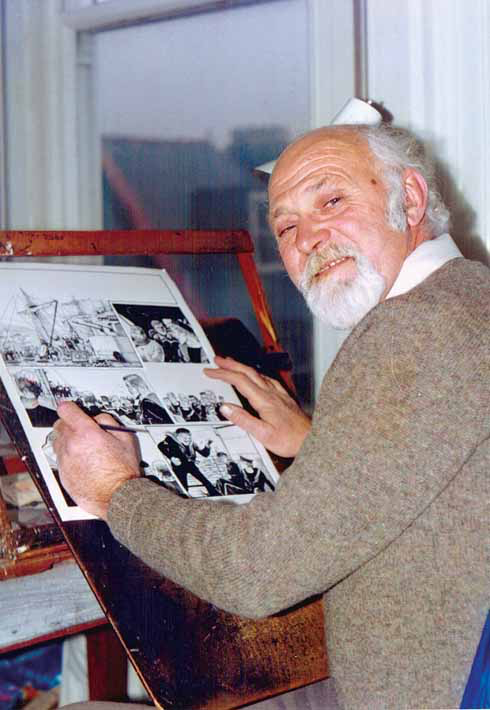
Joe’s technique was crucial to his bold style. Charley’s War took him five to seven working days to complete the three pages (more in earlier years).
“Joe was incredibly conscientious,” his widow, Mary, recalled in 2014 in an interview with Dorset Life. “He was always at his desk by 9.30 every morning and he worked right through until six or seven in the evening and often much later. The scripts would arrive and he would have to draw three pages a week, every week, for ‘Charley’s War’, plus whatever extra work he had taken on as well. He was always taking on extra jobs when we needed the money. If we ever took a holiday it was a nightmare for him as he would have to do all the work in advance.”
His daughter Jane, herself an artist, remembers her dad constantly working, invariably to a tight deadline, although she says he always had time for the family.
“He never seemed to mind being interrupted even though it must have been terribly annoying for him. We knew he drew but we didn’t take much notice, if anything all these war stories were a bit of a turn off. Other people were much more impressed by his work; to us it was just what he did. The ironic thing is that if he was working today he would enjoy far greater recognition.”
Joe often had to go straight to inks when drawing the strip – such was the level of detail required – but if he had time, his working method was as follows…
DAY ONE Joe penciled in the layout and frames on artboard. He started this after making a very quick thumbnail drawing on scrap paper.
DAY TWO With the penciling finished, Joe started to ink the strip in. He worked with a series of finer and finer brushes and works thickest to finest. (The complete opposite of most other artists who work back-to foreground). The boldest of his brushwork was laid in over the entire three pages. He then returned for the next brush and so on.
DAY THREE With the boldest brush lines in he now chose his mid range brush to add details such as facial features and headgear. This was the most time-consuming stage.
DAY FOUR was used to finish this stage.
DAY FIVE was the finishing day, where detail such as shading and uniform details are added this is done with a dip pen with a fine nib. Sometimes Joe would add white ink or Guache in white on black if needed. Very often, if the pages were a particularly dense story in terms of what was demanded of his skills, Joe would be pushed into the weekend to finish.
• Read an interview with Joe Colquhoun here
• Dorset Life: From Roy of the Rovers to World War 1 – Joe Colquhoun
A feature published in September 2014. Nick Churchill on the extraordinary body of work of Swanage illustrator Joe Colquhoun
Charley’s War created by Pat Mills and Joe Colquhoun | CHARLEY’S WAR ™ REBELLION PUBLISHING LTD, COPYRIGHT © REBELLION PUBLISHING LTD, ALL RIGHTS RESERVED
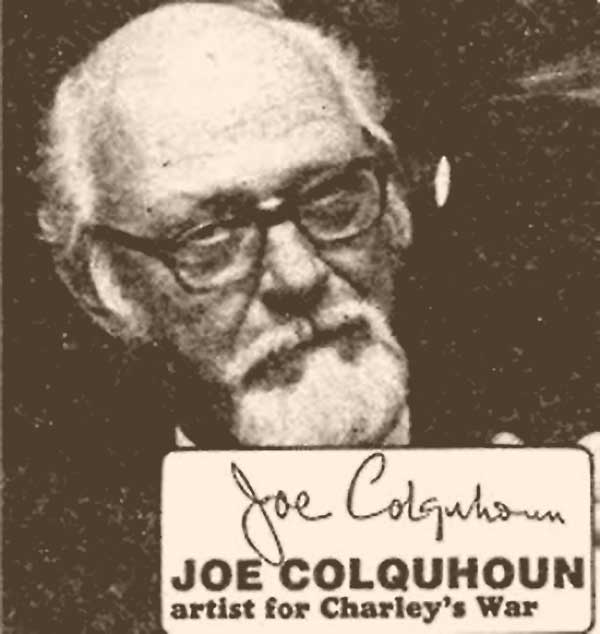
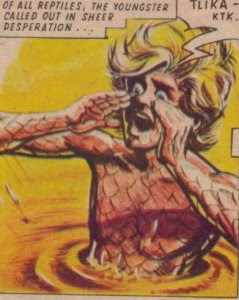


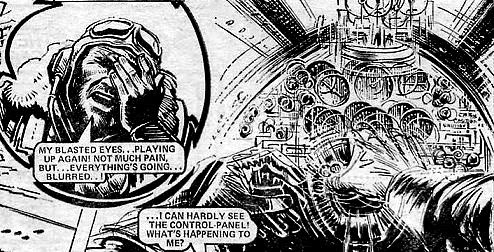
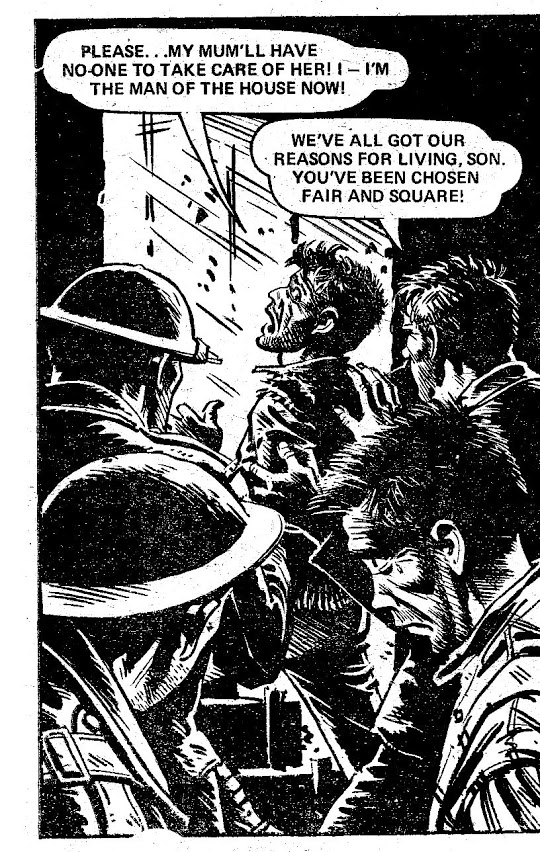

Great to see Joe get the recognition he deserves.
What a fantastic article on the the great Joe Colquhoun a artist that deserves more recognition for his brilliant artwork over the years.
CHARLEY’S WAR is now regarded as one of the best if not the best of British comics strips along with the marvellous Pat Mills scripts him and Joe made one of the greatest teams of comics of all time.